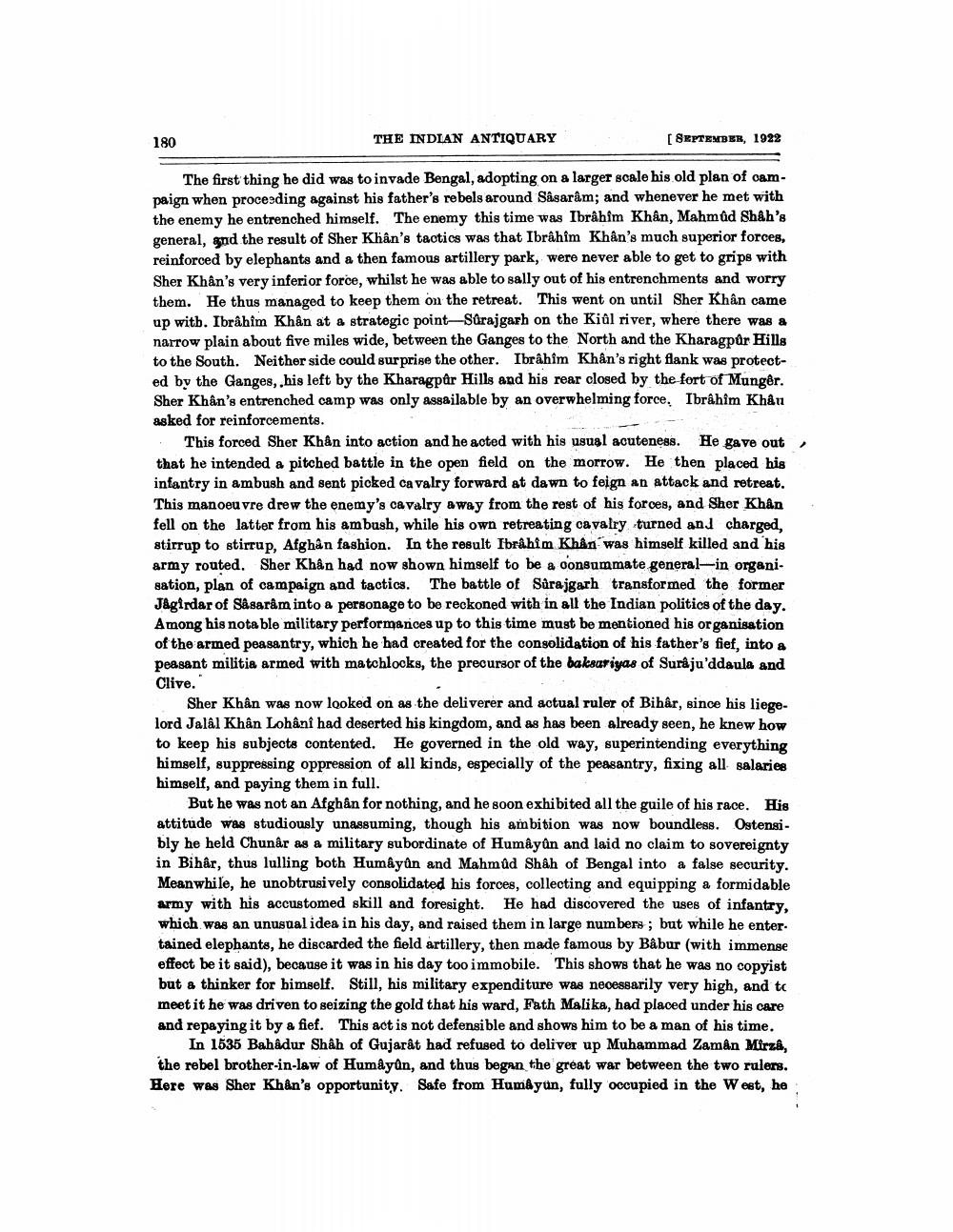________________
180
THE INDIAN ANTIQUARY
[SEPTEMBER, 1922
The first thing he did was to invade Bengal, adopting on a larger scale his old plan of oampaign when proceeding against his father's rebels around Sasaram; and whenever he met with the enemy he entrenched himself. The enemy this time was Ibrahim Khân, Mahmud Sh&h's general, and the result of Sher Khan's tactics was that Ibrahim Khân's much superior forces, reinforced by elephants and a then famous artillery park, were never able to get to grips with Sher Khan's very inferior force, whilst he was able to sally out of his entrenchments and worry them. He thus managed to keep them on the retreat. This went on until Sher Khân came up with. Ibrahim Khân at a strategic point-Sarajgarh on the Kidl river, where there was a narrow plain about five miles wide, between the Ganges to the North and the Kharagpur Hills to the South. Neither side could surprise the other. Ibrahim Khan's right flank was protected by the Ganges, his left by the Kharagpůr Hills and his rear closed by the fort of Mungêr. Sher Khan's entrenched camp was only assailable by an overwhelming force. Ibrahim Khâu asked for reinforcements.
This forced Sher Khân into action and he acted with his usual acuteness. He gave out, that he intended a pitched battle in the open field on the morrow. He then placed his infantry in ambush and sent picked Cavalry forward at dawn to feign an attack and retreat. This manoeuvre drew the enemy's cavalry away from the rest of his forces, and Sher Khân fell on the latter from his ambush, while his own retreating cavalry turned and charged, stirrup to stirrup, Afghan fashion. In the result Ibråhim Khan was himself killed and his army routed. Sher Khân had now shown himself to be a consummate general-in organisation, plan of campaign and tactics. The battle of Sarajgarh transformed the former J&girdar of Sâsarâm into a personage to be reckoned with in all the Indian politics of the day. Among his nota ble military performances up to this time must be mentioned his organisation of the armed peasantry, which he had created for the consolidation of his father's fief, into a peasant militia armed with matchlocks, the precursor of the baksariyas of Surâ ju'ddaula and Clive."
Sher Khân was now looked on as the deliverer and actual ruler of Bihar, since his liegelord Jalal Khân Lohânî had deserted his kingdom, and as has been already seen, he knew how to keep his subjects contented. He governed in the old way, superintending everything himself, suppressing oppression of all kinds, especially of the peasantry, fixing all salaries himself, and paying them in full.
But he was not an Afghan for nothing, and he soon exhibited all the guile of his race. His attitude was studiously unassuming, though his ambition was now boundless. Ostensibly he held Chunar as a military subordinate of Humayun and laid no claim to sovereignty in Bihar, thus lulling both Humayan and Mahmud Shah of Bengal into a false security. Meanwhile, he unobtrusively consolidated his forces, collecting and equipping a formidable army with his accustomed skill and foresight. He had discovered the uses of infantry. which was an unusual idea in his day, and raised them in large numbers; but while he enter. tained elephants, he discarded the field artillery, then made famous by Bâbur (with immense effect be it said), because it was in his day too immobile. This shows that he was no copyist but a thinker for himself. Still, his military expenditure was necessarily very high, and to meet it he was driven to seizing the gold that his ward, Fath Malika, had placed under his care and repaying it by a fief. This act is not defensible and shows him to be a man of his time.
In 1535 Bahadur Shâh of Gujarât had refused to deliver up Muhammad Zaman Mirza, the rebel brother-in-law of Humayun, and thus began the great war between the two rulers. Here was Sher Khan's opportunity. Safe from Humayun, fully occupied in the West, he




